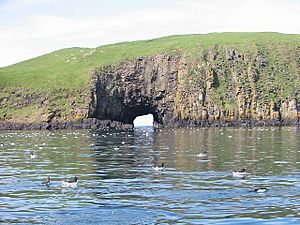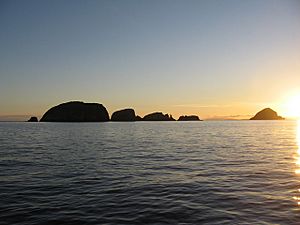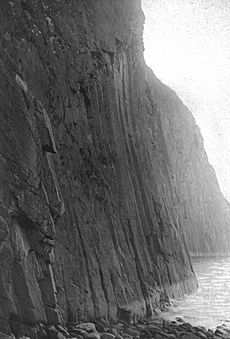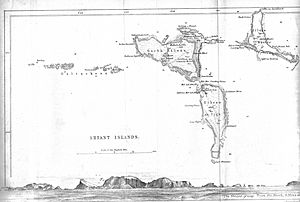Shiant Islands facts for kids
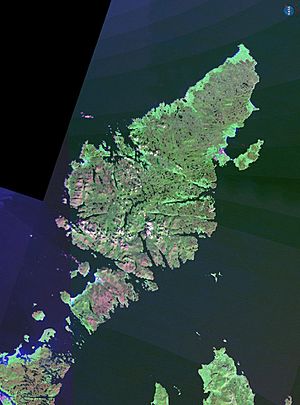
The Shiant Islands (Scottish Gaelic: Na h-Eileanan Mòra or Na h-Eileanan Seunta) are a group of islands that are privately owned. They are located in the Minch, a sea area east of Harris in the Outer Hebrides of Scotland. These islands are about 5 miles (8 km) southeast of the Isle of Lewis.
Contents
What's in a Name? The Shiant Islands' Meaning
The name Shiant comes from the Scottish Gaelic words Na h-Eileanan Seunta. This means "charmed," "holy," or "enchanted isles." The group is also known as Na h-Eileanan Mòra, which means "the big isles."
The main islands are Garbh Eilean ("rough island") and Eilean an Taighe ("house island"). These two are connected by a narrow strip of land called an isthmus. To the east is Eilean Mhuire ("island of the Virgin Mary"). Before the 1800s, Eilean an Taighe was called Eilean na Cille, meaning "island of the church."
Old maps from the 1600s and 1700s show different names for these islands. Garbh Eilean was called Nunaltins Isle, Eilean Mhuire was St Marys Isle, and Eilean an Taighe was St Columbs Isle. This last name suggests that a church on Eilean an Taighe might have been dedicated to a saint named Columba.
Island Landscape: Geography and Geology
The Shiant Islands are located east of the Sound of Shiant. Garbh Eilean and Eilean an Taighe together cover about 143 hectares (353 acres). Eilean Mhuire is much more fertile and covers about 75 hectares (185 acres). To the west, there are also several rocks called Galtachan, including Galta Beag and Galta Mòr.
How the Islands Were Formed
Geologically, these islands are like an extension of the Trotternish peninsula on the Isle of Skye. Their rocks are volcanic, meaning they were formed from cooled lava. These rocks are quite young, about 60 million years old, compared to other rocks in the Hebrides.
You can see amazing columns of rock on the north side of Garbh Eilean. These columns are made of a rock called dolerite. They are over 120 meters (390 feet) tall and about 2 meters (6.6 feet) wide. They are similar to the famous columns at Staffa and the Giant's Causeway. These columns formed when hot volcanic rock cooled very slowly deep underground.
In some areas, the volcanic rock, called basalt, is covered by older Jurassic mudstone. This mudstone breaks down to create very fertile soil. This is different from most other places in the Western Isles, where the soil is not as rich.
You can visit the Shiant Islands by taking various cruise ships. These ships operate from other Hebridean Islands and from mainland Scotland.
A Look Back: History of the Shiant Islands
In 1549, a man named Donald Monro, who was a church leader, wrote about "Ellan Senta." He said it was more than 2 miles (3 km) long and good for growing crops, raising animals, and fishing. He also mentioned a "vault" or cave on the east side, which was like a tunnel. People used to row small boats through this tunnel to avoid rough seas outside. This cave is now known as Toll a' Roimh, or the "Hole of the Seals."
About 150 years later, in 1703, Martin Martin wrote that the two southern islands are only separated at high tide. He said that Island-More (Eilean Mhuire) had a chapel dedicated to the Virgin Mary and was good for corn and grass. The island next to it on the west was only used for grazing animals.
Owners of the Islands
At the start of the 1900s, only eight people lived on the Shiant Islands. The famous author and politician Compton MacKenzie owned the islands from 1925 to 1937. He loved islands and visited the Shiants several times, though he never lived there.
In 1937, a young student named Nigel Nicolson bought the islands. He used money he inherited from his grandmother. Nigel Nicolson later became a writer, publisher, and politician, just like Compton MacKenzie. Nigel's son, Adam Nicolson, wrote a well-known book about the islands called Sea Room (2001). Today, the Shiant Islands belong to Adam's son, Tom Nicolson.
Sheep have grazed on the islands since the mid-1800s. The Nicolson family keeps a simple hut, called a bothy, on Eilean an Taighe. This is the only building on any of the islands where people can stay.
Amazing Animals: Wildlife of the Shiant Islands
The Shiant Islands are home to a huge number of seabirds. Tens of thousands of Atlantic puffins nest in burrows on the slopes of Garbh Eilean. You can also find many common guillemots, razorbills, northern fulmars, black-legged kittiwakes, common shags, gulls, and great skuas here. While there are fewer puffins than on the remote island of St Kilda, they are much more crowded together on the Shiants.
Getting Rid of Rats
Until recently, the islands also had a population of black rats (Rattus rattus). It's thought they first came ashore from a shipwreck. The Shiant Islands were one of the only places in the UK where black rats could still be found. In winter, there were about 3,500 rats, and their numbers grew a lot in summer. Scientists found that these rats ate seabirds, but they weren't sure if they hunted live birds or just ate dead ones.
To protect the seabirds, a project began in the winter of 2015-2016 to remove all the rats from the Shiant Islands. This was part of the Shiant Isles Seabird Recovery Project. Many groups helped fund this project, including the EU, SNH, and RSPB. In March 2018, the Shiant Islands were officially declared rat-free! This was a big success for protecting the island's bird populations.
See also
 In Spanish: Islas Shiant para niños
In Spanish: Islas Shiant para niños



